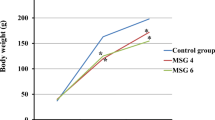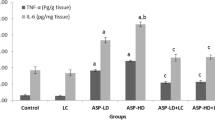Abstract
This study aimed to investigate the effects of acetaldehyde (AA) and L-carnitine (LC) on morphology and enzyme activity of myocardial mitochondria in rats. Sixty-five Wistar rats were randomly divided into 4 groups: the control group (n = 20), the AA low-dose group (n = 15), the AA high-dose group (n = 15) and the AA + LC group (n = 15). Different doses (110 mg/kg and 220 mg/kg) AA was injected intraperitoneally once a day for 4 weeks. After 4 weeks administration, transmission electron microscope (TEM) observation of morphology of rat myocardial mitochondria was performed. Serum levels of succinate dehydrogenase (SDH), superoxide dismutase (SOD), malondialdehyde (MDA) and cardiac troponin I (cTnI) were detected to evaluate mitochondrial enzymes activities. Light micrograph of rat myocardiocytes in the control group showing normal architecture of myocytes. The numerical density and number of mitochondria in both low-dose and high-dose AA groups were lower than that of the control group. After administration of LC, the rats in the AA + LC group showed an obvious increase in the numerical density and number of mitochondria. TEM showed that both low-dose and high-dose AA could induce myocardial mitochondrial damage in rats in a dose-dependent manner, such as mitochondrial swelling, disruptions of crest and membrane, mitochondrial deficiency. The degree of mitochondrial damage of the AA + LC group was significantly decreased after administration of LC. Our results showed that serum levels of SDH and SOD in the AA + LC and control groups were also higher than those of the low-dose and high-dose AA groups; while the MDA level in the AA + LC and control groups were lower than that of the low-dose and high-dose AA groups. The low-dose AA, high-dose AA and AA + LC groups exhibited a higher level of serum cTnI than that of the control group. However, there was no significant difference in serum cTnI level among the low-dose AA, high-dose AA and AA + LC groups. Our findings indicate that AA may lead to myocardial mitochondrial damage and the induction of enzyme activity in rats, while administration of LC could alleviate AA-related damage of rat myocardial mitochondria.



Similar content being viewed by others
References
Piano MR (2002) Alcoholic cardiomyopathy: incidence, clinical characteristics, and pathophysiology, Chest 121:1638–1650. http://www.ncbi.nlm.nih.gov/pubmed/12006456
Balakumar P, Singh AP, Singh M (2007) Rodent models of heart failure. J Pharmacol Toxicol Methods 56:1–10. doi:10.1016/j.vascn.2007.01.003
Chen CH, Sun L, Mochly-Rosen D (2010) Mitochondrial aldehyde dehydrogenase and cardiac diseases. Cardiovasc Res 88:51–57. doi:10.1093/cvr/cvq192
Marin-Garcia J, Akhmedov AT, Moe GW (2013) Mitochondria in heart failure: the emerging role of mitochondrial dynamics. Heart Fail Rev 18:439–456. doi:10.1007/s10741-012-9330-2
Huang H, Liu N, Guo H, Liao S, Li X, Yang C, Liu S, Song W et al (2012) L-carnitine is an endogenous hdac inhibitor selectively inhibiting cancer cell growth in vivo and in vitro. PLoS ONE 7:e49062. doi:10.1371/journal.pone.0049062
Kumaran S, Deepak B, Naveen B, Panneerselvam C (2003) Effects of levocarnitine on mitochondrial antioxidant systems and oxidative stress in aged rats. Drugs R D 4:141–147.http://www.ncbi.nlm.nih.gov/pubmed/12757399
Seifert EL, Estey C, Xuan JY, Harper ME (2010) Electron transport chain-dependent and -independent mechanisms of mitochondrial H2O2 emission during long-chain fatty acid oxidation. J Biol Chem 285:5748–5758. doi:10.1074/jbc.M109.026203
Ringseis R, Keller J, Eder K (2012) Role of carnitine in the regulation of glucose homeostasis and insulin sensitivity: evidence from in vivo and in vitro studies with carnitine supplementation and carnitine deficiency. Eur J Nutr 51:1–18. doi:10.1007/s00394-011-0284-2
Yamada H, Hironaka Y, Hama T (1990) Effects of levocarnitine chloride, a new mitochondrial function reactivating agent, on fatty acid and glucose oxidation under hypoxic condition in homogenates from rat heart]. Yakugaku Zasshi 110:225–234. http://www.ncbi.nlm.nih.gov/pubmed/2374095
Cheng CP, Cheng HJ, Cunningham C, Shihabi ZK, Sane DC, Wannenburg T, Little WC (2006) Angiotensin II type 1 receptor blockade prevents alcoholic cardiomyopathy. Circulation 114:226–236. doi:10.1161/CIRCULATIONAHA.105.596494
Aistrup GL, Kelly JE, Piano MR, Wasserstrom JA (2006) Biphasic changes in cardiac excitation-contraction coupling early in chronic alcohol exposure. Am J Physiol Heart Circ Physiol 291:H1047–H1057. doi:10.1152/ajpheart.00214.2006
Liang Q, Carlson EC, Borgerding AJ, Epstein PN (1999) A transgenic model of acetaldehyde overproduction accelerates alcohol cardiomyopathy. J Pharmacol Exp Ther 291:766-772. http://www.ncbi.nlm.nih.gov/pubmed/10525098
Doser TA, Turdi S, Thomas DP, Epstein PN, Li SY, Ren J (2009) Transgenic overexpression of aldehyde dehydrogenase-2 rescues chronic alcohol intake-induced myocardial hypertrophy and contractile dysfunction. Circulation 119:1941–1949. doi:10.1161/CIRCULATIONAHA.108.823799
McIntosh-Kastrinsky R, Diaz-Sanchez D, Sexton KG, Jania CM, Zavala J, Tilley SL, Jaspers I, Gilmour MI et al (2013) Photochemically altered air pollution mixtures and contractile parameters in isolated murine hearts before and after ischemia. Environ Health Perspect 121:1344–1348. doi:10.1289/ehp.1306609
Oba T, Maeno Y, Nagao M, Sakuma N, Murayama T (2008) Cellular redox state protects acetaldehyde-induced alteration in cardiomyocyte function by modifying Ca2 + release from sarcoplasmic reticulum. Am J Physiol Heart Circ Physiol 294:H121–H133. doi:10.1152/ajpheart.00520.2007
Zhang X, Li SY, Brown RA, Ren J (2004) Ethanol and acetaldehyde in alcoholic cardiomyopathy: from bad to ugly en route to oxidative stress. Alcohol 32:175–186. doi:10.1016/j.alcohol.2004.01.005
Jing L, Jin CM, Li SS, Zhang FM, Yuan L, Li WM, Sang Y, Li S et al (2012) Chronic alcohol intake-induced oxidative stress and apoptosis: role of CYP2E1 and calpain-1 in alcoholic cardiomyopathy. Mol Cell Biochem 359:283–292. doi:10.1007/s11010-011-1022-z
Evans AM, Fornasini G (2003) Pharmacokinetics of L-carnitine. Clin Pharmacokinet 42:941–967. doi:10.2165/00003088-200342110-00002
Weinhandl ED, Rao M, Gilbertson DT, Collins AJ, Pereira BJ (2007) Protective effect of intravenous levocarnitine on subsequent-month hospitalization among prevalent hemodialysis patients, 1998 to 2003. Am J Kidney Dis 50:803–812. doi:10.1053/j.ajkd.2007.07.017
Das SK, Vasudevan DM (2007) Alcohol-induced oxidative stress. Life Sci 81:177–187. doi:10.1016/j.lfs.2007.05.005
Fridovich I (2011) Superoxide dismutases: Anti- versus pro- oxidants? Anticancer Agents Med Chem 11:175–177. http://www.ncbi.nlm.nih.gov/pubmed/21182471
Rahman K (2007) Studies on free radicals, antioxidants, and co-factors. Clin Interv Aging 2:219–236. http://www.ncbi.nlm.nih.gov/pubmed/18044138
Guimaraes R, Barros L, Barreira JC, Sousa MJ, Carvalho AM, Ferreira IC (2010) Targeting excessive free radicals with peels and juices of citrus fruits: grapefruit, lemon, lime and orange. Food Chem Toxicol 48:99–106. doi:10.1016/j.fct.2009.09.022
Niki E (2009) Lipid peroxidation: physiological levels and dual biological effects. Free Radic Biol Med 47:469–484. doi:10.1016/j.freeradbiomed.2009.05.032
Meguid NA, Dardir AA, Abdel-Raouf ER, Hashish A (2011) Evaluation of oxidative stress in autism: defective antioxidant enzymes and increased lipid peroxidation. Biol Trace Elem Res 143:58–65. doi:10.1007/s12011-010-8840-9
Acknowledgments
We would like to acknowledge the helpful comments on this paper received from our reviewers.
Conflict of interest
We declare that we have no conflicts of interest.
Author information
Authors and Affiliations
Corresponding author
Rights and permissions
About this article
Cite this article
Jin, YZ., Wang, GF., Wang, Q. et al. Effects of acetaldehyde and L-carnitine on morphology and enzyme activity of myocardial mitochondria in rats. Mol Biol Rep 41, 7923–7928 (2014). https://doi.org/10.1007/s11033-014-3686-4
Received:
Accepted:
Published:
Issue Date:
DOI: https://doi.org/10.1007/s11033-014-3686-4




